SD › Italy › Florence › Rome to Florence
Updated: March 16, 2024
By Santorini Dave
See Also

Buying train tickets in the Florence train station. Trains between Florence and Rome run almost constantly: about every 2 to 10 minutes daily. You can buy tickets in the train station but for express trains it’s usually best to reserve in advance.
How to get to Florence from Rome
- Booking Train Tickets in Italy: The best site for booking Italy train tickets online and in advance is ItaliaRail.com. It’s typically how I buy train tickets when in Italy. (Though for last-minute trips I tend to use the station kiosks.)
- By train: There are two types of trains connecting Rome with Florence, express trains and local trains. Express trains are the best option for travelers, offering spacious seating, quick transfer (usually only an hour and a half), affordable rates, easy luggage storage, and amenities like wifi, electrical outlets, a food carriage with a café or vending machines, and restrooms (including those with wheelchair access). Local trains can be a great option for budget travelers, as tickets are sometimes (but not always) cheaper than express tickets. Local trains usually take about three to three and a half hours, but can take over seven, so be sure to check the duration of the train ride before booking. Restrooms are on all trains, and some offer wifi and in-seat power; local trains do not offer food or beverages. I recommend booking train tickets in advance.
- By bus: Buses are slightly cheaper than local trains, and take about the same amount of time, anywhere from three and a half up to seven hours. Flixbus is the best bus operator serving this route. All buses include on board wifi, snacks, and restrooms.
- By driving: Renting a car is a great option if your trip to Florence includes a few day trips to other Tuscan cities or into the wine country. But if the bulk of your travel days will be spent in Florence itself, then a car is more trouble than it’s worth, due to the limited and expensive parking and the fact that most hotels in Florence are inside the pedestrian-only zone. The drive takes a little over three hours via the most direct route, which includes a toll road. Taking an alternate route which avoids most tolls takes over four hours.
- By air: ITA Airways runs 4 daily flights between Rome and Florence. Tickets are affordable, and flights take only 55 minutes. However, the time it takes getting to and from each airport and clearing security makes this both a more expensive and more time consuming option than taking an express train.
Rome-Florence Train Schedules
Trains running from Roma Termini train station to Firenze Santa Maria Novella (Firenze SMN, the main train station in Florence), run almost constantly, about every 2 to 10 minutes, depending on the time of day.
Italo runs most of the express trains, while Trenitalia runs most of the local trains.
Rome to Florence weekday train service begins at 5:35 a.m. and ends at 8:55 p.m., though there are two overnight local trains leaving at ten minutes after midnight and arriving at 6:38 a.m. and 7:34 a.m.
Weekend and holiday trains depart slightly later in the mornings, around 5:45 or 6:00 a.m., and run until 10:35 p.m.
Rome-Florence Train Fares
Prices for tickets from Roma Termini to Firenze SMN vary widely, with express tickets ranging from €15.90 to €61 and local trains ranging from €14 to €23. Trains are cheapest in the mornings before 6:45, and are most expensive during morning and evening rush hours, since these trains are popular for business travelers.
Express trains offer both first and second class seating options, while local trains only offer second class. The difference between express train ticket classes is not much. Second class seats are spacious, recline, and come with free wifi and power outlets. First class seats are a little bigger, usually have more luggage storage, and sometimes come with a welcome drink and snack. For such a short trip, it’s not worth paying for the first class upgrade, since tickets are two to three times the price, and the amenities are mostly the same.
Italo offers discounts for children, seniors, and families. Children under 36 months ride free with no seat assignment and sitting in an adult’s lap; if an adult travels with more than one infant, a second seat must be purchased. Italo’s Family program allows everyone in a family to have assigned seats together, and at a discount: a booking must be made for two to four people, where at least one is over 18. In that case all children under 14 in that group ride free (infants under 36 months aren’t counted since they ride free anyway). Seniors receive a 40% discount when booking three days in advance.
Trenitalia allows children at or under 4 years old to ride free if they sit in an adult’s lap. Children from 4-11 are charged at a 50% discount off adult fare and get their own seat. Seats can be purchased for children under 4 at the standard child rate, too (do this if using a car seat). Trains are rarely full, so if the train starts moving and there are empty seats near, it is ok for the younger kids to use them. They also have their Bimbi Gratis program, where children under 15 ride free. To take advantage of this, tickets must be purchased two days in advance as part of a family group of 2-5 people, with at least one adult. Adult fares remain the same; just the child tickets are free.
Italo and Trenitalia tickets can be purchased at the designated kiosks or ticket offices at the Roma Termini station on the day of travel. These are located in the station lobby on Platform level. They can also be purchased online (Trenitalia, Italo) 24 hours or more before the train’s scheduled departure.
Wait Times and Delays
Italian trains (and buses, for that matter) are frequently delayed by a few minutes. Delays can happen anytime, but they are most frequent around the major holidays of Christmas and Easter when there are more passengers.
Delays can also be caused by worker strikes, though these are never by surprise. All strikes must be announced two weeks in advance, cannot last more than 24 hours, and are never allowed in July, August, late December, early January, or in the days around Easter or elections. In the case of a strike, trains still operate – but on a limited schedule.
In the case that a delay is long enough that it causes a passenger to miss a connection, the purchased ticket can be redeemed on the next train out, within an hour after the original train’s departure time. If the train they need to connect to is the last train of the evening, let the conductor know; they may be able to have that train wait.
Rome to Florence with Kids
In general, all children under 12 must be accompanied by an adult. Children ages 12-16 may travel alone with a signed consent form from their parent or legal guardian. Contact Trenitalia directly for details on unaccompanied minors.
Italo offers discounts for children, seniors, and families. Children under 36 months ride free with no seat assignment and sitting in an adult’s lap; if an adult travels with more than one infant, a second seat must be purchased. Italo’s Family program allows everyone within a family to have assigned seats together, and at a discount: a booking must be made for two to four people, where at least one is over 18. In that case all children under 14 in that group ride free (infants under 36 months aren’t counted, since they ride free anyway). Seniors receive a 40% discount when booking three days in advance.
Trenitalia offers children at or under 4 years old to ride free if they sit in an adult’s lap. Children from 4-11 are charged at a 50% discount off adult fare and get their own seat. Seats can be purchased for children under 4 at the standard child rate, too (do this if using a car seat). Trains are rarely full, so if the train starts moving and there are empty seats near, it is ok for the younger kids to use them. They also have their Bimbi Gratis program, where children under 15 ride free. To take advantage of this, tickets must be purchased two days in advance as part of a family group of 2-5 people, with at least one adult. Adult fares remain the same; just the child tickets are free.
Food On Board or at the Station
Italo’s express trains to Rome have vending machines onboard with coffee, sodas, and snacks. Each seat comes with a table; groups of four have a larger shared table.
Roma Termini station houses a three-story mall with restaurants, cafes, and even a grocery store inside. The three levels are Underground, Platform (ground level), and First Floor. Most of the restaurants are in the northwest portion – facing Piazza Cinquecento – on any of the three levels. Mercato Centrale Roma is especially good. The grocery store is on the Underground Level.
There are also plenty of amazing restaurants just outside the station, the best among them being Er Buchetto (wine bar) and Nerone (casual Italian).
Location of the Train Stations
Roma Termini is located downtown, near the Roman National Museum, Baths of Diocletian, and the Papal Basilica of Santa Maria Maggiore. The University is due east, with several small specialty museums inside, including ones devoted to medicine, math, chemistry, and more. It is walking distance (20 to 30 minutes) to the Colosseum, Forum, Pantheon, and Trevi Fountain.
Santa Maria Novella is in the heart of Florence, walking distance to all of Florence’s major attractions, including the Duomo, Uffizi Gallery, and the Accademia, though it is especially close to San Lorenzo Church, San Lorenzo Market, the Medici Chapels, and the Oficina Profumo. Several budget hotels surround the station with some of the city’s best restaurants and bars within five to ten minutes’ walk.
Rome to Florence by Train
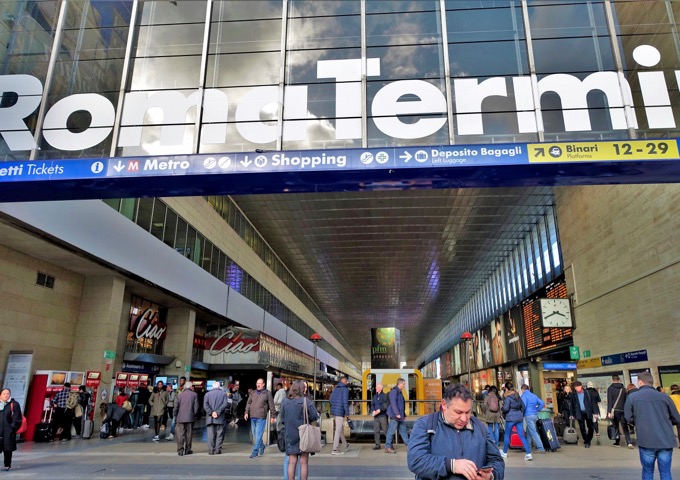
Roma Termini is the largest train station in Italy and one of the largest in Europe. It includes a three-story mall in the front, and 28 platforms in the rear on the ground floor (Platform Level). All of the ticketing offices are located on the Platform level, as well as Left Luggage (baggage drop off) and Sala Blu (assistance for the disabled) stations.
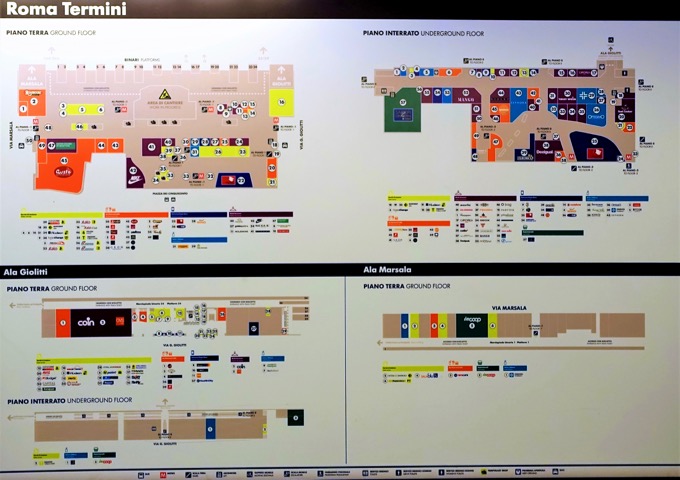
All signs are written in Italian and English, including the maps placed in several prominent locations throughout the station. This map shows the main entry and gallery areas for the Underground and Platform Levels, as well as the two wings that flank the train platforms. Restaurants are all labelled in bright orange; services and amenities are shown in yellow (Sala Blu disability assistance is #4 on the Platform Level, Marsala wing and Ki Point left luggage is #6 in the Giolitti wing); clothing stores are dark purple; the grocery and convenience stores are in dark green; and other shops, including the pharmacy are in blue. All restrooms are on the Underground Level with two on either side of the main gallery and one in the middle of the Giolitti wing.
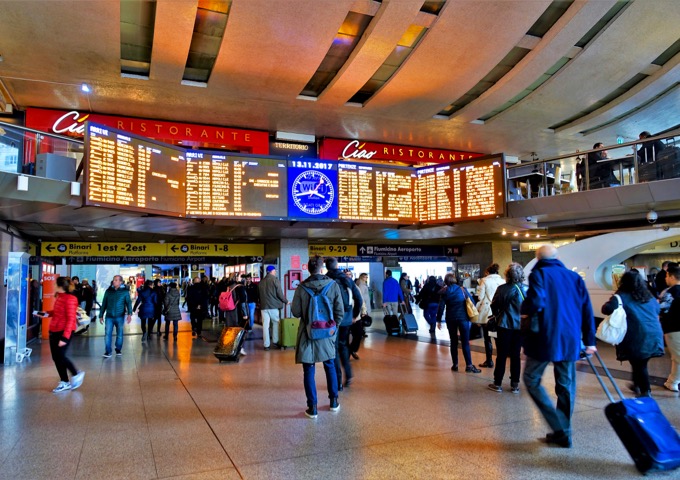
The main entrance on the Platform Level has a large display, listing the most recent train arrivals on the two left screens and train departures on the two right screens. Listings begin with the train number, then the final destination, departure time, and its platform. A train from Rome to Florence may end in Venice and so be listed as a Venice-bound train. To find your platform using these signs, use your train number. Platform 1 is the far left platform from the entry, while Platform 24 is on the far right. Platforms 25 and above are on the right, behind the all of the other platforms. There are cafés, restaurants, and shops on all three floors. There are several sets of stairs and five sets of elevators.
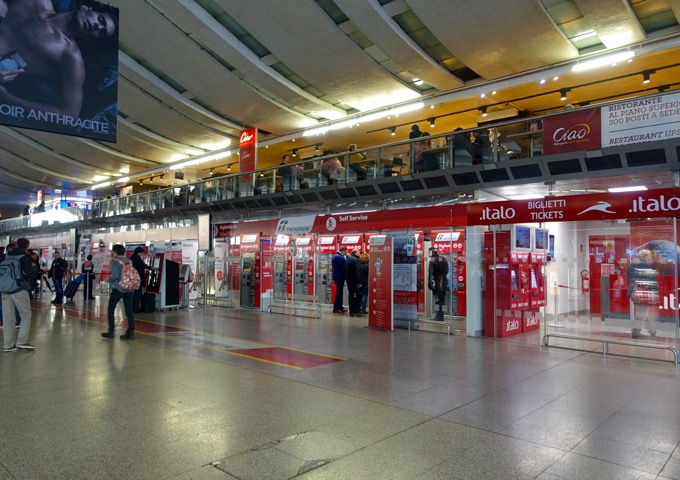
Turning to the left from this main entrance is the station lobby with self-serve ticketing kiosks for Italo and Trenitalia trains. More shops and restaurants can be seen on the upper floor, and there is another electronic display of departing trains, just outside of the frame of this photo on the left side.

View further to the left. There are even more self-serve kiosks, mostly for Trenitalia here. Italo train tickets are straight ahead, on the other side of the staircase.
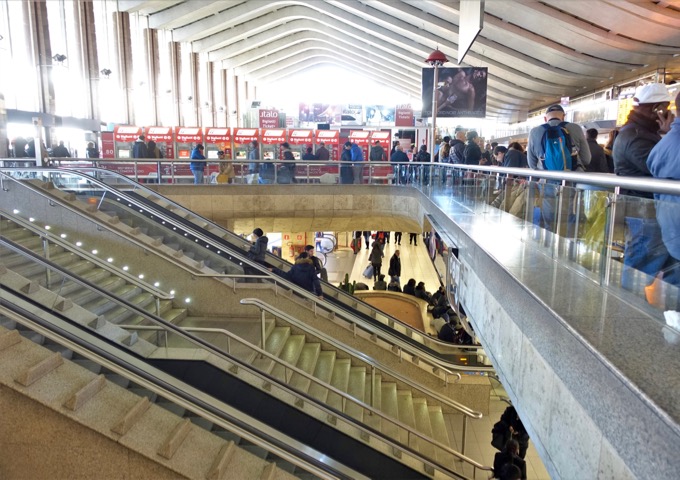
View from the staircase. The Underground Level has more shops, restaurants, and all of the restrooms. On the Platform Level straight ahead behind the Trenitalia kiosks is the Italo ticketing area.
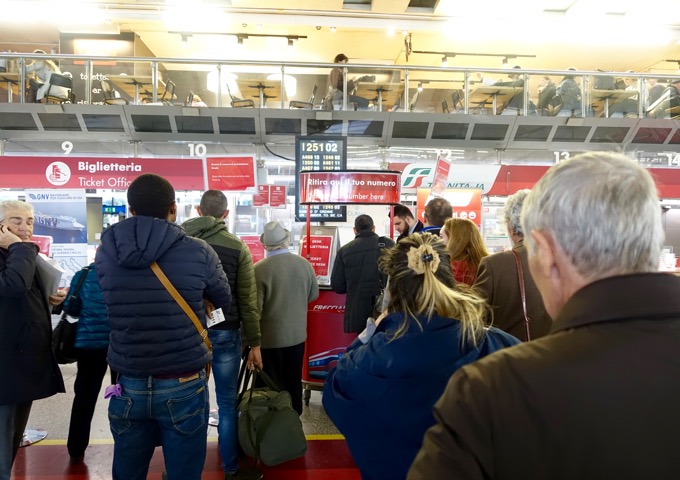
To save time, don’t buy tickets from the agent at the ticketing office, unless you have a very specific request. The lines are long and chaotic. Use the kiosks, or better yet, buy your tickets online in advance.
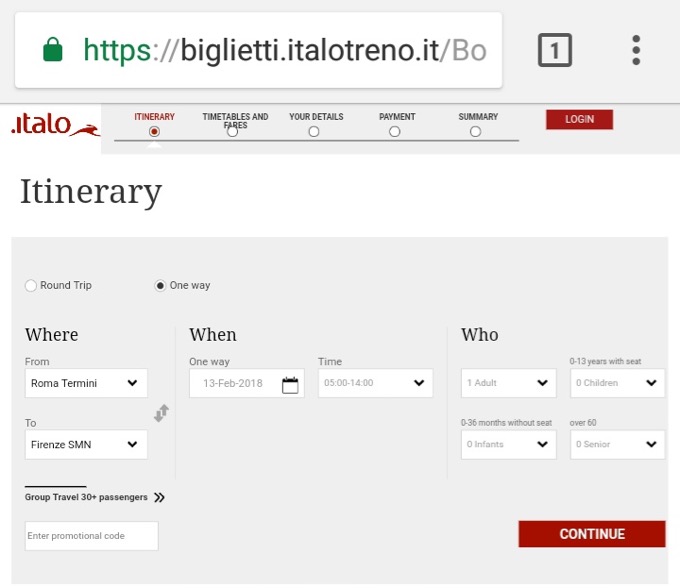
Italo offers the fastest and often the cheapest trains. To buy online, visit www.biglietti.italotreno.it. Depart from Roma Termini to Firenze SMN (Firenze Santa Maria Novella, the main train station in Florence). Select the date and time range you prefer; departures are listed in military time, where 14:00 is 2:00 p.m. Select the number of adults and children in the group. Choose a one-way or round-trip.
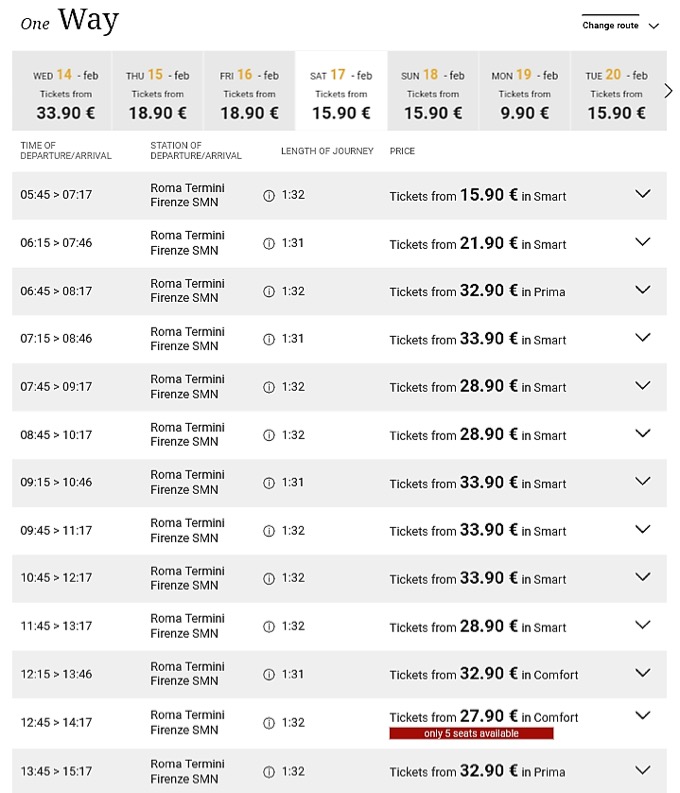
All of the trains departing during the selected time frame will be displayed on the next screen, along with departure and arrival times and the duration of the trip. If a train is close to selling out, the number of remain tickets will be displayed in red. Prices vary based on how popular that departure time is and which type of ticket is purchased. Monday’s tickets are as low as €9.90. Booking ahead online is the best way to save money on train tickets.
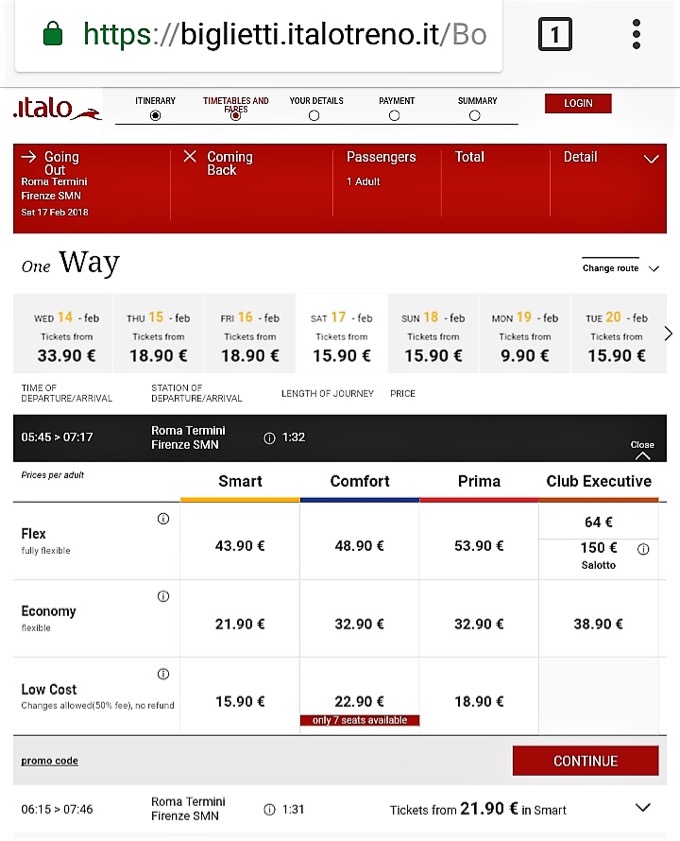
Select the ticket type, whether Smart, Comfort, Prima, or Club Executive. Smart is the basic ticket, with spacious, reclining seats with footrests, tables, individual power outlets, wifi, and access to the vending machines onboard. Comfort has bigger seats. Prima comes with welcome drinks and snacks that are served to each passenger. Club Exec includes access to the lounge at the station. Smart is the most popular option for short trips like this one.
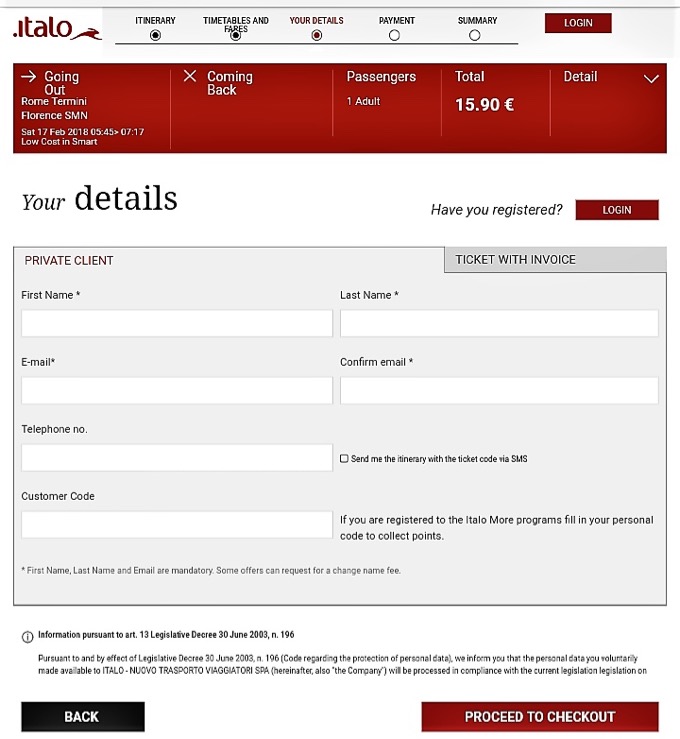
Enter details and check out.
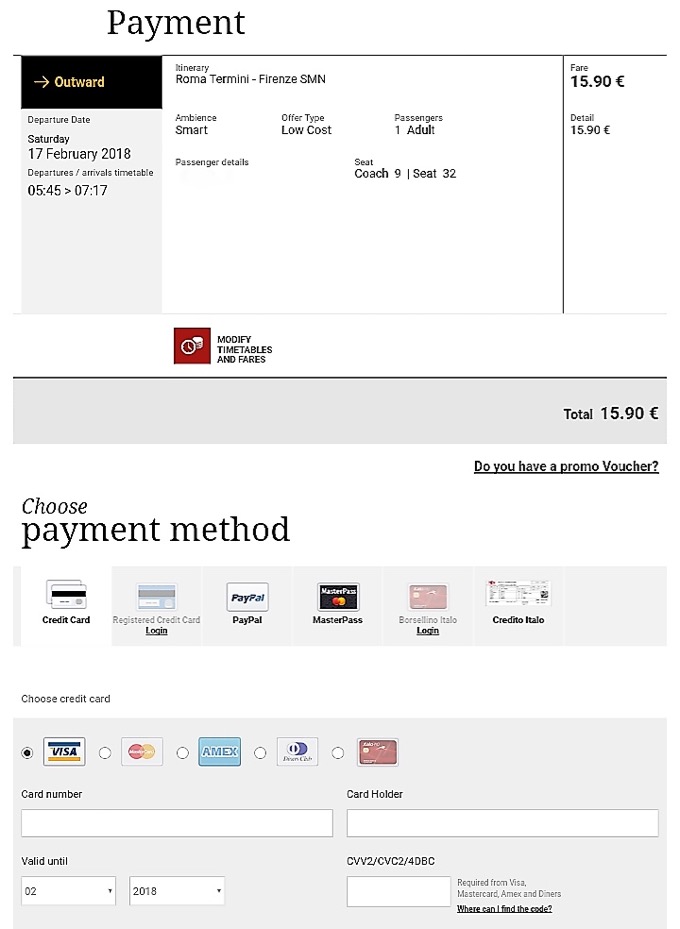
Confirm your passenger information and pay with a credit card or PayPal. You will receive an e-ticket for boarding – show this to the officers onboard the train.
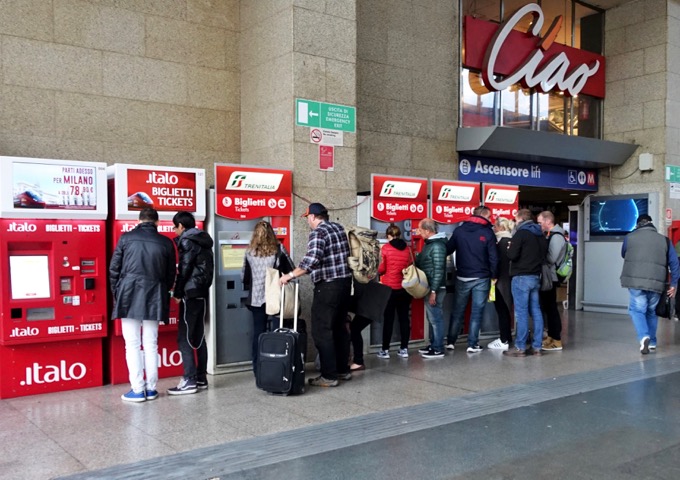
Alternatively, you may purchase tickets at one of the kiosks.
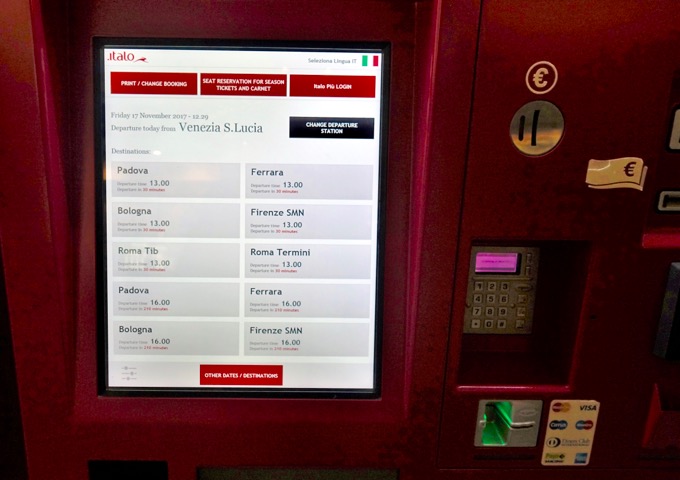
These examples are from Venice, but the machines work the same way. “Departure from Roma Termini” will already be filled in. Select Firenze S.M. Novella as your destination.
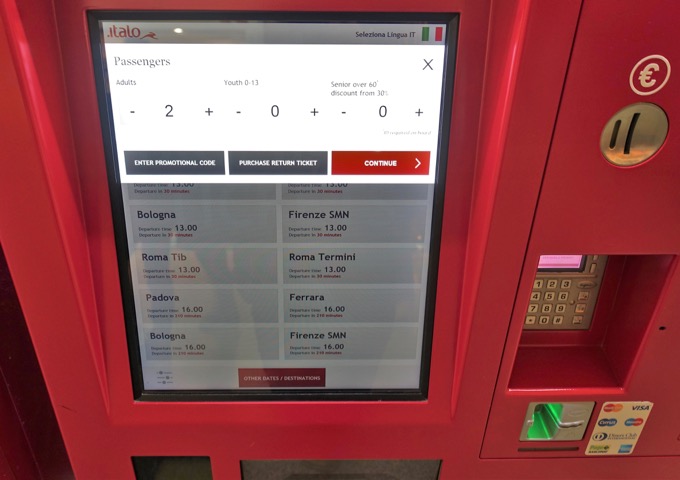
Select the number of adults, children, and seniors in the group.
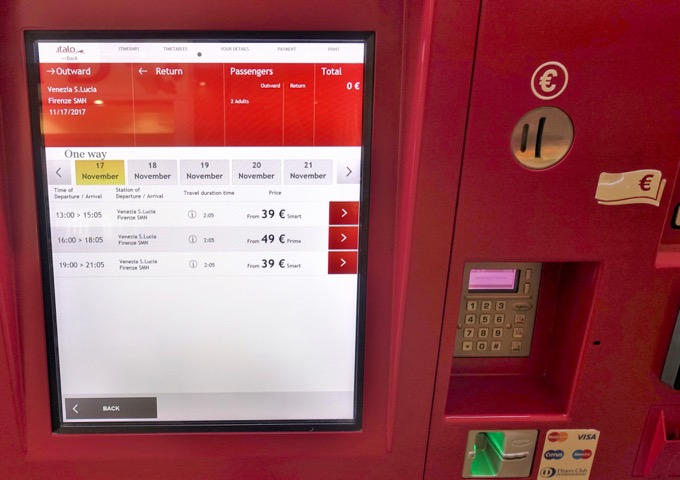
Choose your preferred time and type of seat.
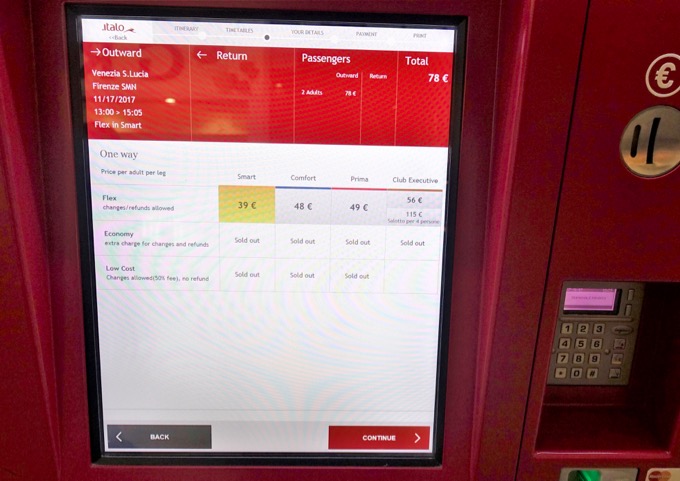
Tickets purchased at the train station on the day of travel will be limited and more expensive than those purchased in advance.
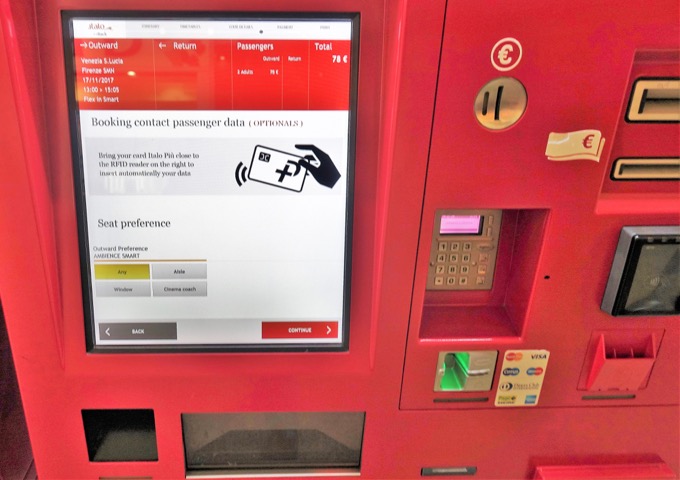
Add contact details and any available perks if you prefer. This part is optional. Pay at the kiosk with credit cards (where the green light is), with contactless cards (right of the keypad), with coins (upper right), or with Euro notes (upper right). Retrieve your ticket from behind the plastic window at the bottom.
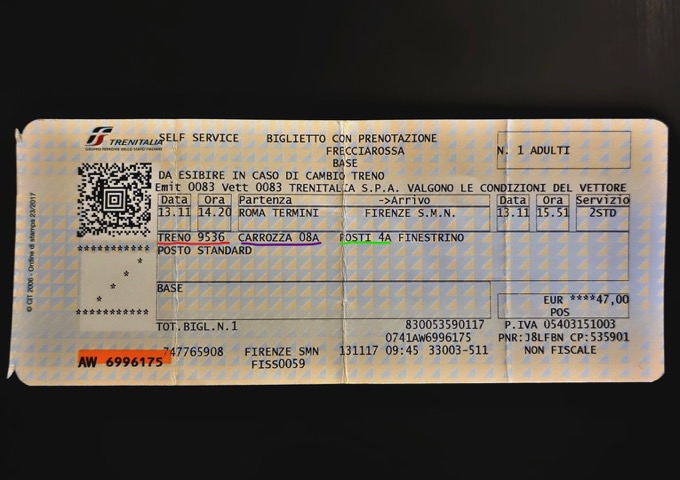
An example of a Trenitalia ticket. The train number is labeled “Treno” and underlined in red; use this number to find your platform for boarding. Seats on all express trains, whether run by Italo or Trenitalia are assigned. The seat on this train is located in Carriage 8, labelled Carrozza 08 and underlined in purple. The seat number is 4A, labelled “Posti 4A.” This is a window seat, “Finestrino;” an aisle seat will be labelled “Corridoio.” Electronic tickets will include the same information with a QR code to scan for entry.
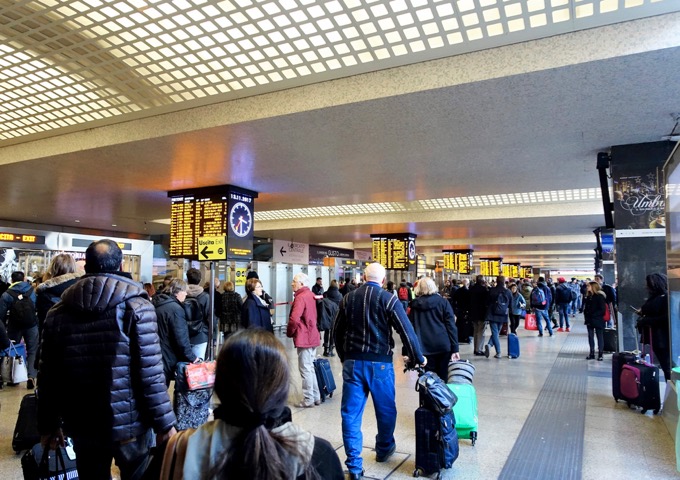
With your ticket, you can head toward the platforms, located behind the ticketing offices. There are several electronic displays showing the most recent info on trains, including any delays. Exit the station lobby toward the platforms seen on the left here.
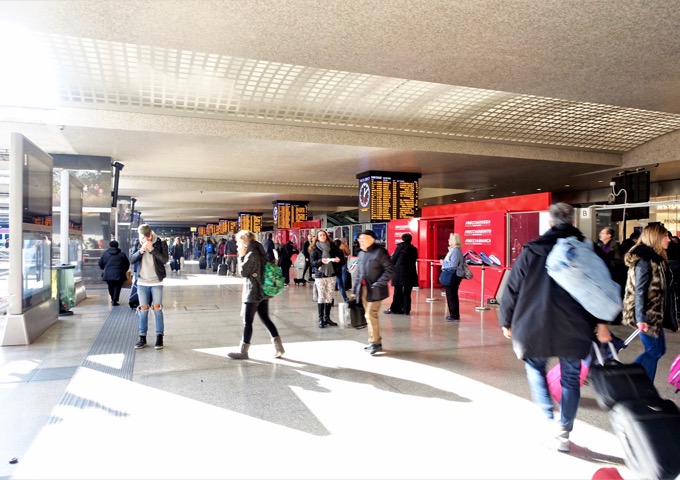
Interior view in front of the platforms. Platforms are to the left, the station and mall are to the right. All platforms are on the same level, accessible from this main area.
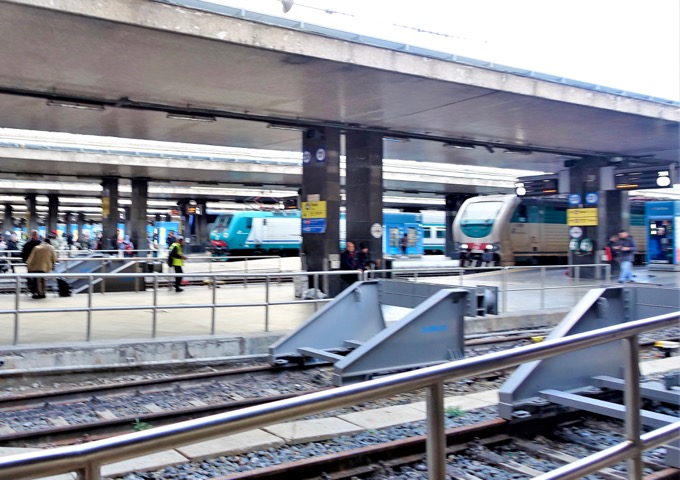
Trains at the Roma Termini platforms.
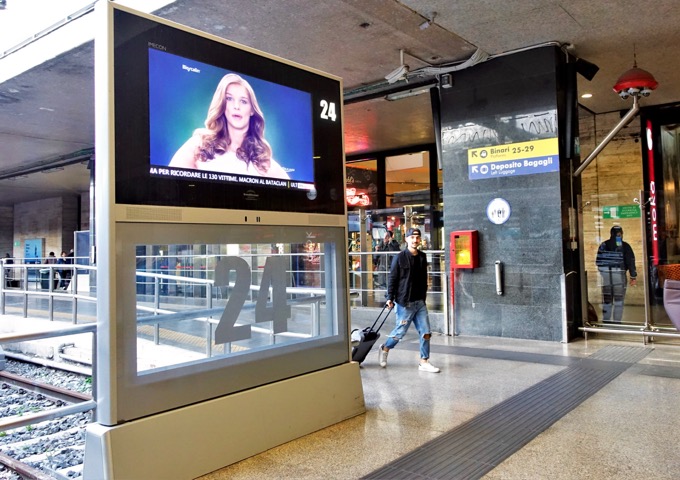
Back to the station. From Platform 24, it is easy to reach the baggage drop for quick sightseeing. See the blue “Deposito Bagagli/Left Luggage” sign underneath the yellow one. Make a left here and continue straight alongside the platform.
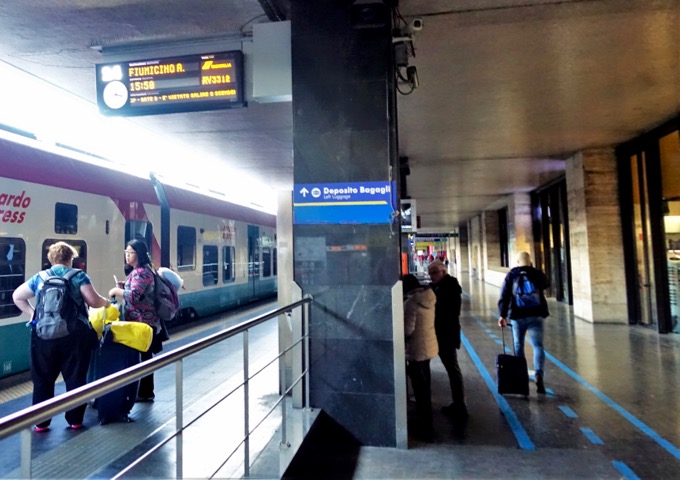
Continue to follow the blue signs along the blue path. This is the Giolitti wing of the station.
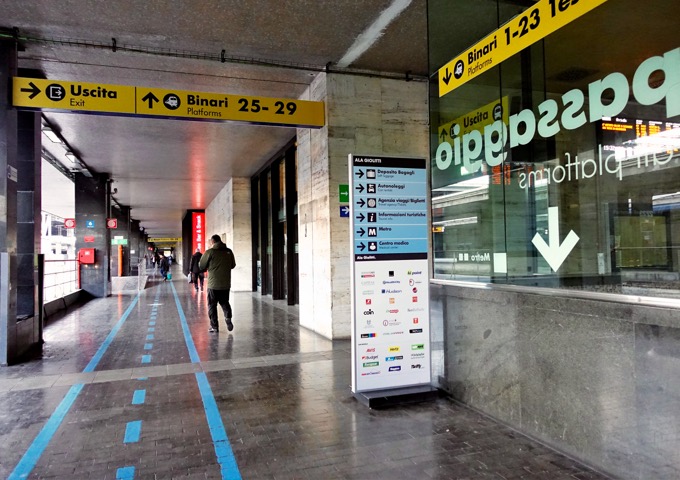
Hang a right to reach the Left Luggage. Car rentals, buses, tourist info, and the medical center are also around the corner.
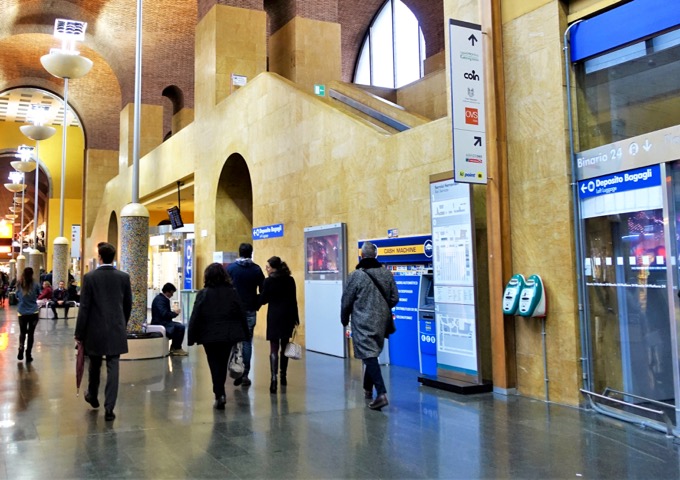
Turning right around the corner, here are two ticket validating machines (the green and white machines on the wall, next to the glass window on the right) and an ATM machine that dispenses Euros. Continuing straight all the way leads to the mall, food, and back to the station lobby.
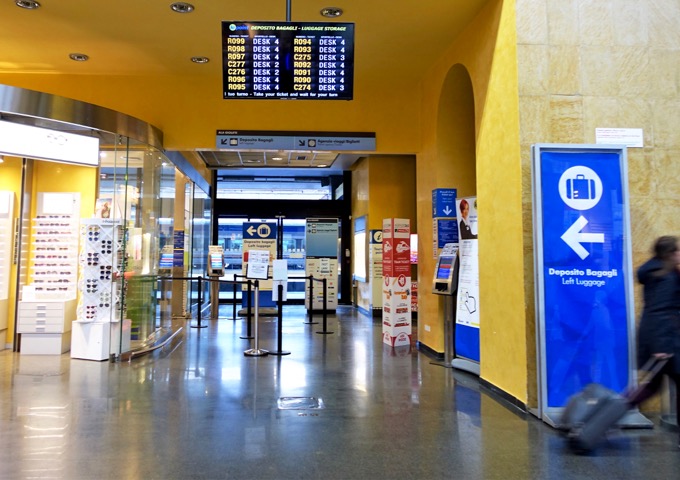
The Ki Point Left Luggage is just past the ATM. The tourist info point is directly across the hall. There are two kiosks in the hallway; take a number from one of these to reserve your space in line.

Drop offs to the left; pickups on the right. Wait for your number to be called for service.
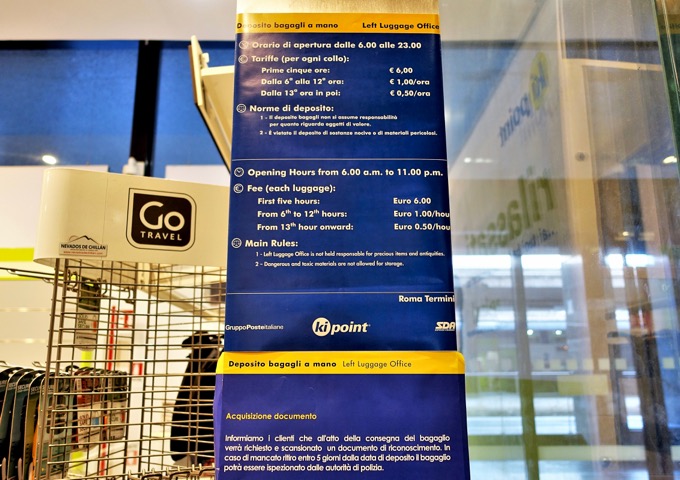
Rates and hours are displayed here.
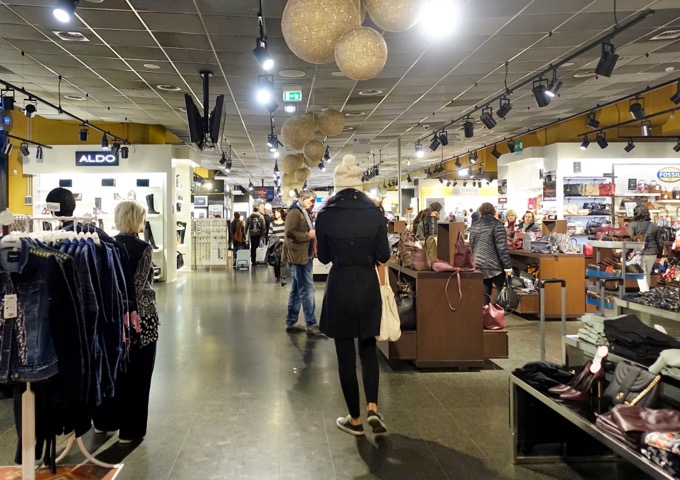
Straight down the hall, past the baggage deposit, leads to the mall…
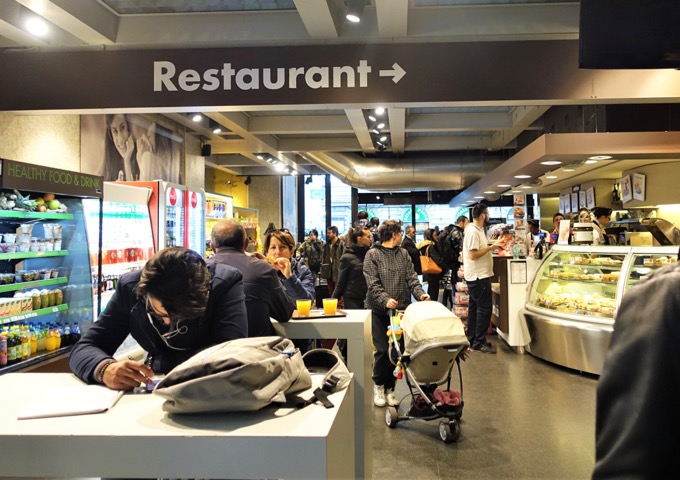
And restaurants…
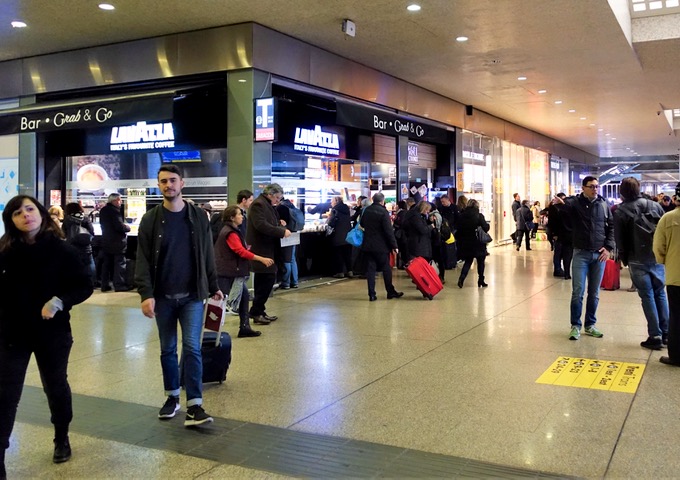
And cafes and the station lobby.
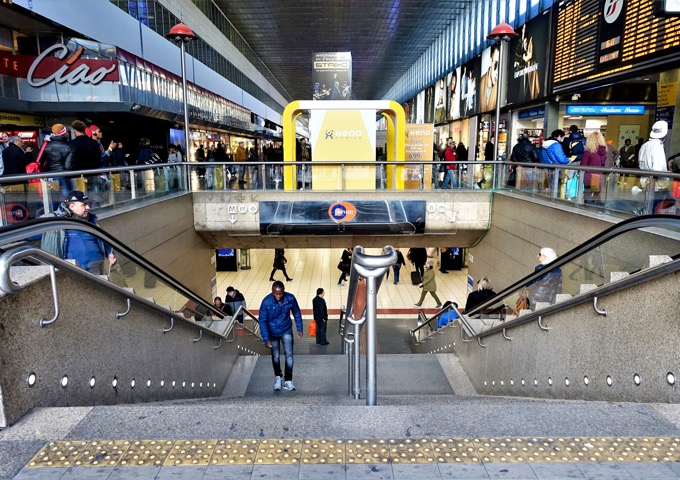
Heading downstairs leads to the restrooms. There is also a small grocery store and a pharmacy on this level, and five ATMs (three near the Foot Locker, one kitty-corner from Sephora, and one more in front of the grocery store).
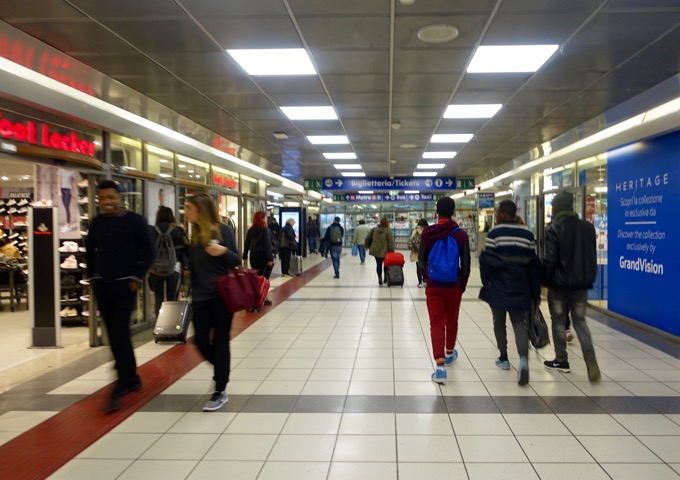
Underground Level shops.
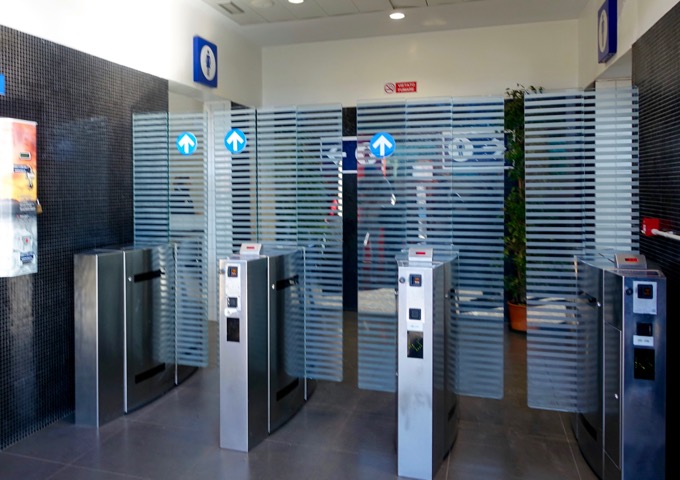
Restrooms are all on this floor, accessible for €1 per person. This can only be paid in coins. There is a change machine before you go through the barriers.

Now, to catch the train. If you have a paper ticket, you must validate it in one of these machines scattered throughout the stations. To do so, align the ticket to the left and insert it face down in the machine to get stamped. If you have an electronic ticket, be sure it is easy to access, as you will need to show it to the officers on board the train.
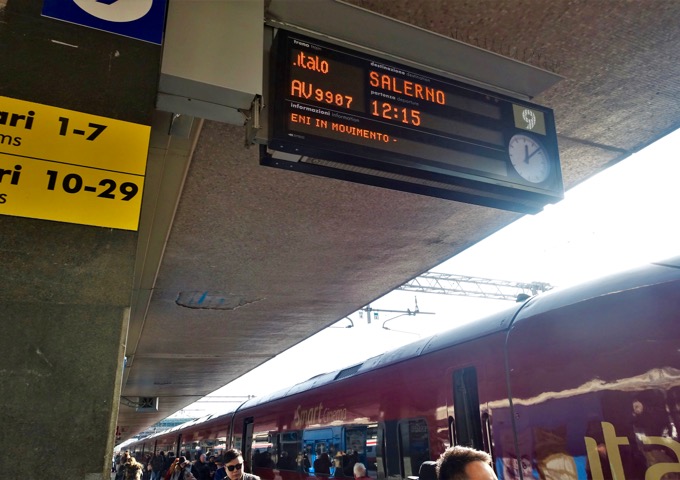
Find your platform. The platform number will be on the corner closest to the train tracks. The destination may not match with your ticket, so go by the train number, which will be shown on the sign below the city name. This platform is servicing train 9907, with Salerno as its final destination.
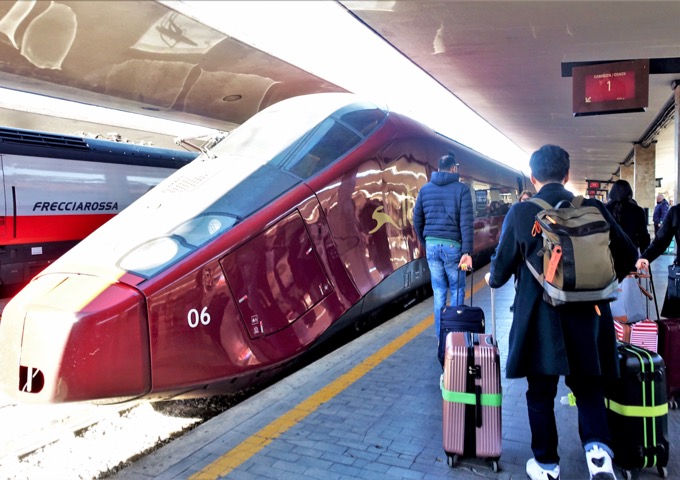
Once you’ve located your platform and train, find your carriage. The carriage numbers are on the red signs that read “Carrozza/Coach” above the platform. The train parks so that each carriage is aligned with its proper number.
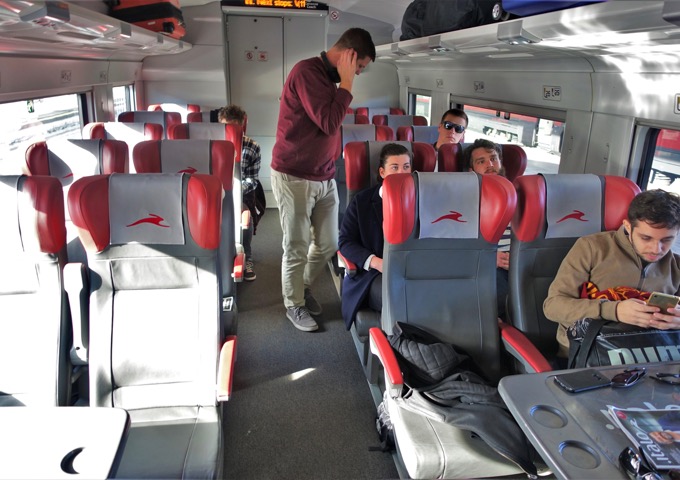
Find your seat. These are in Italo’s Smart category. Numbers are listed above each window. There is storage for carry-on-sized luggage above each seat, just like on a plane.
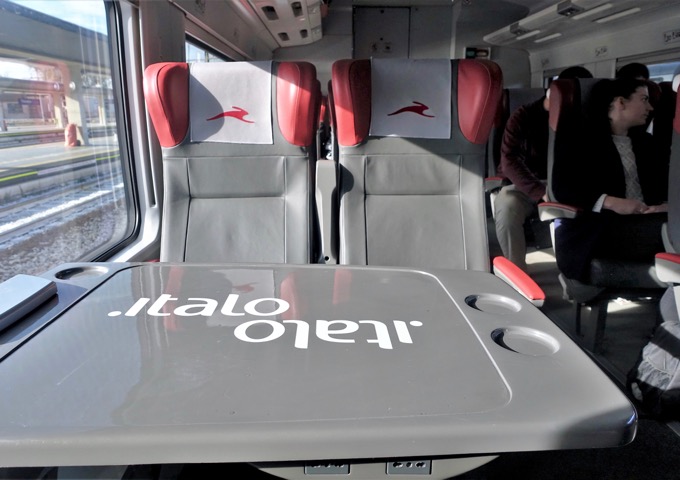
Each chair has a small table. Groups of four have a larger shared table, shown here. Just below the table, the in-seat power outlets are just visible.
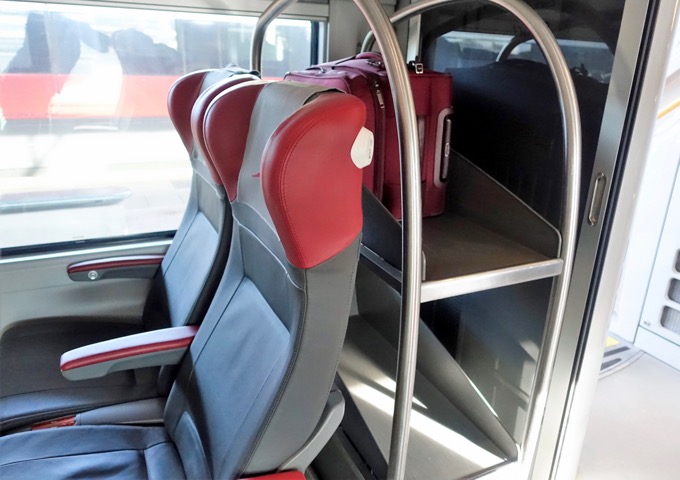
Additional luggage storage is found behind the seats at the end of the carriage…
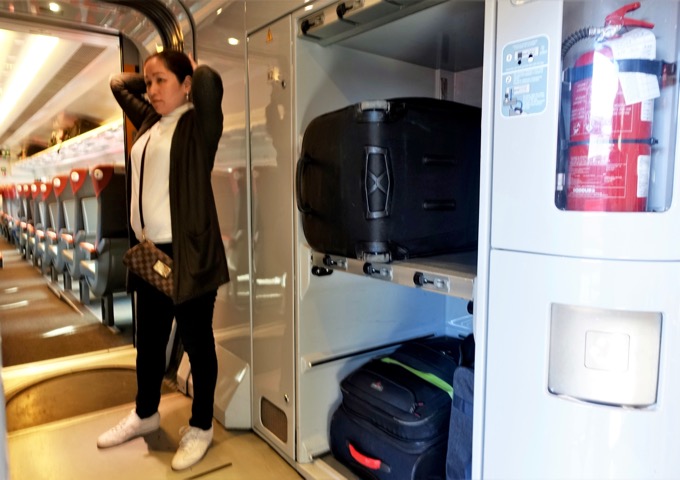
And larger luggage goes in between each carriage.
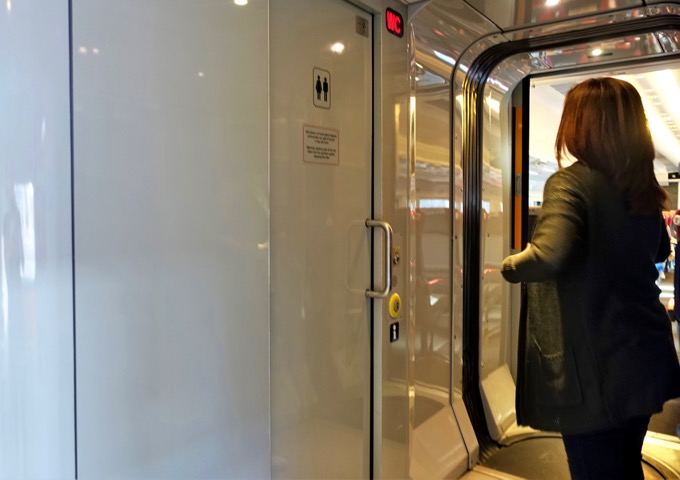
This is also where to find the restrooms.
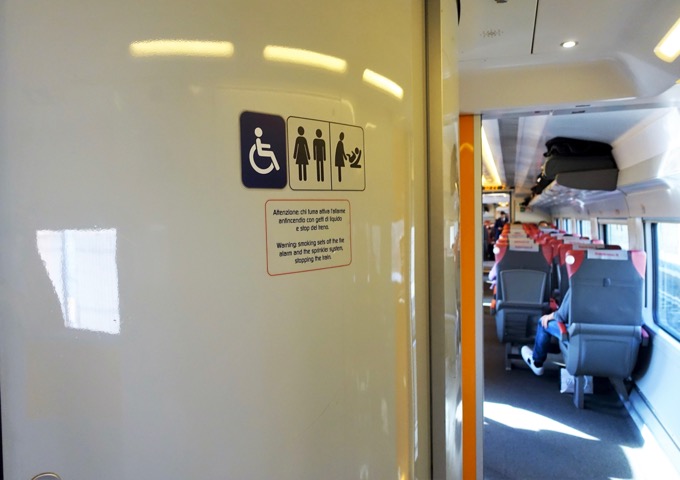
Accessible restrooms and baby changing stations are available toward the middle of the train.
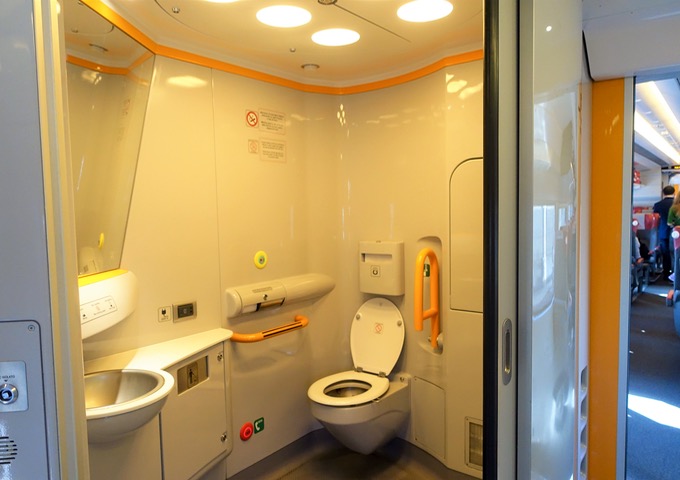
They are much larger than the standard restrooms and include grip bars.
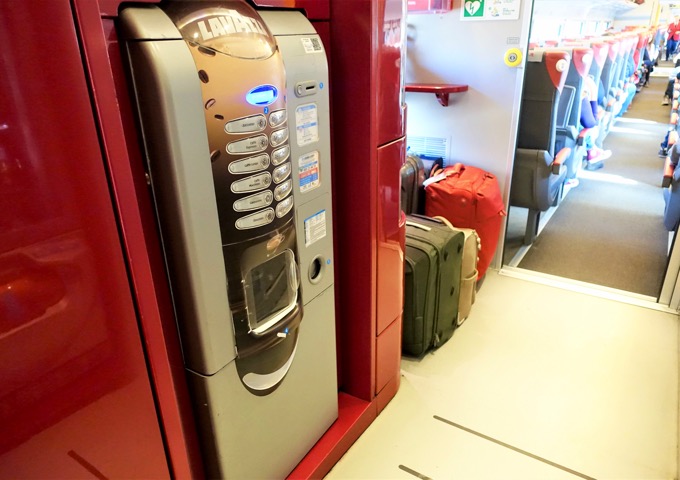
Vending machines for coffee, tea…
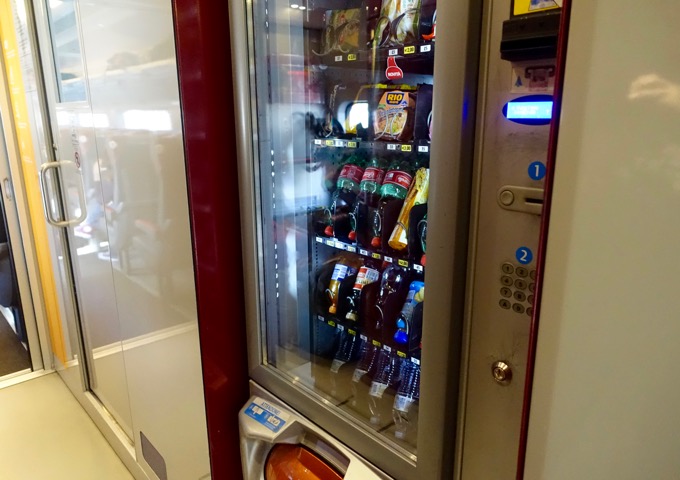
….cold drinks, and snacks are available toward the middle/front of the train.
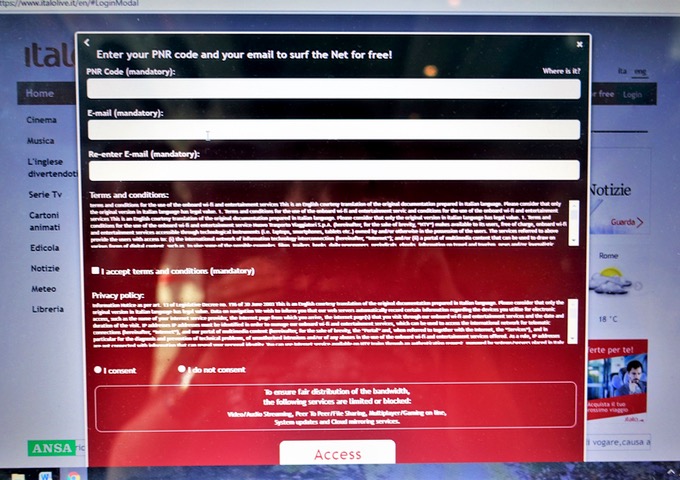
Wifi is available for free.
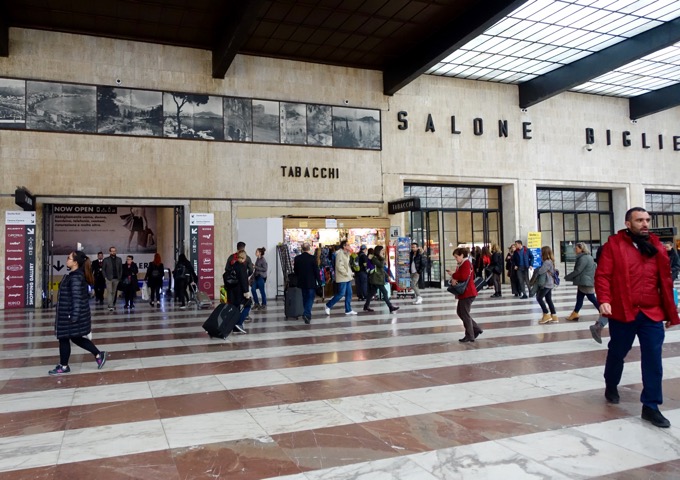
Arrive in Florence! Firenze SMN station has several restaurants and shops inside, and a mini mall in the underground level. Facing the shops, the main exits will be on the left past Platform 16 or straight ahead-ish, through the ticket office marked “Salone Biglietteria,” seen here to the right of the tobacco shop.
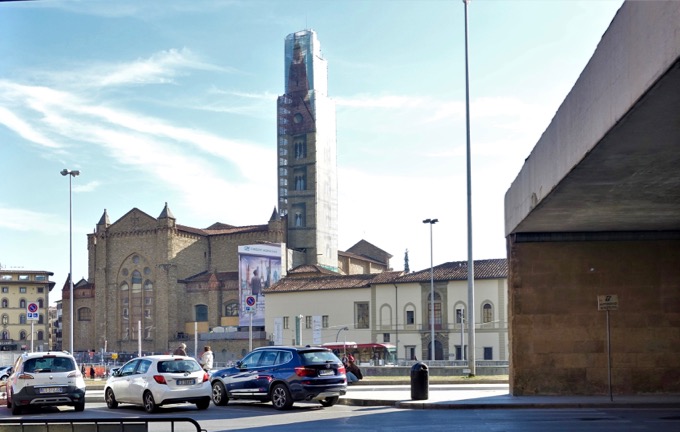
View of Santa Maria Novella Church directly across from the train station. You can catch a taxi right here or walk to most hotels in Florence’s City Center (Duomo), San Marco, and San Lorenzo neighborhoods.
About Santorini Dave